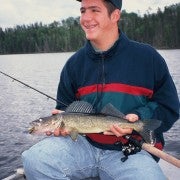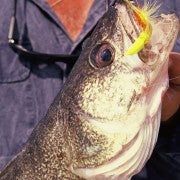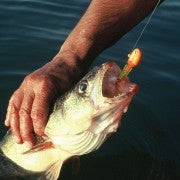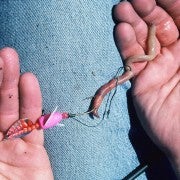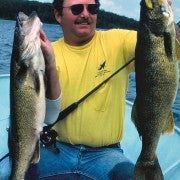Understanding Ontario Walleyes
Bob McNally 02.23.15
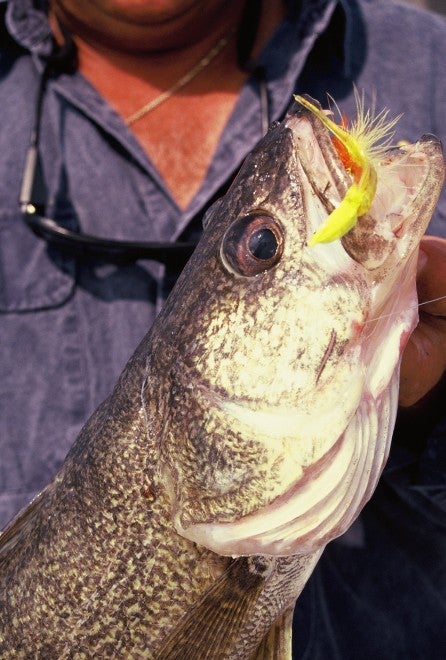
No fish is more sought-after in Ontario than the walleye. This great-eating and fun-to-catch species is found throughout the province in rivers, lakes, and waters large and small.
Every Ontario walleye habitat has its own challenges for anglers, but fishermen who understand these simple truths about the species will catch fish consistently.
Seasonal Walleye Migrations in Ontario
Walleyes are predictable in their seasonal migration patterns. It starts in early spring, when walleyes travel great distances for spawning. In Ontario, for example, biologists have documented walleyes migrating up to 175 miles to spawn.
Following spawning, walleyes scatter toward summer haunts. They prowl shallow water widely during post-spawn seeking baitfish, which are limited. Cool water, low-sun angle, and limited food dictates post-spawn walleyes stalking shallows for long duration over a broad area.
With warming water and abundant summer forage, walleyes catch food with relative ease, allowing them to spend most of their time in deep water where light penetration and water temperature is to their liking. Feeding sorties into the shallows only need be brief because of bountiful baitfish.
As water temperatures cool in autumn, walleyes feed more often in shallows and for longer duration. Baitfish become scarce and more difficult for walleyes to locate. As water temperature decreases, lakes commonly “turn over,” mixing temperature and oxygen, and allowing bait and walleyes to spread widely from shallow to deep.
By late autumn surface water temperature is colder than in the depths, pushing walleyes down to their preferred range. Walleyes then seek vertical type structures where quick movements into shallows allow for efficient feeding. Walleyes remain in such regions through winter, as they wait for spring and spawning again.
Walleye Vision
The walleye is a notorious low-light and night predator. This is because its highly evolved eyesight enables it to be deadly efficient at seeking and catching prey when it’s most vulnerable. In freshwater, only the sauger (the walleye’s close cousin) reportedly has better dim-light vision than the walleye.
A walleye has an exceptionally large eye, enabling the pupil to gather as much light as possible in even the dimmest light. Its eye is significantly larger, proportionally, than all of its common prey, such as yellow perch, smelt, shad and shiners.
Additionally, a walleye has more rod cells than cone cells in its eye retina than many fish species, providing it with even more superior vision. This is why walleyes commonly prowl the shallows feeding at dawn, dusk, at night, and when the water is turbid in a so-called “walleye chop.”
Walleyes also have “tapetum lucidum,” which is a retina reflective eye layer that concentrates light, similar to that of deer, cats, and raccoons.
Walleyes and Water Temperature
Water temperature dictates much of a walleye’s life, from spawning to feeding, shallow to deep water.
Ice-out surface water temperature of 38 to 45 degrees triggers the spawn in walleyes and sends them at night into feeder rivers or onto wind-swept rocky shores to propagate.
During the spawn and shortly thereafter, walleyes seemingly have lockjaw. But with warming water temperatures of 50 to 60 degrees, walleyes finish spawning and gradually spread throughout a watershed looking for forage, and for a month or so go on a feeding binge.
Biologists report walleyes prefer water temperatures from 60 to 70 degrees and are most active in 73 degree water. Scientific studies also have shown walleye feeding peaks in 64-degree water.
Walleyes grow fast in water 68 to 75 degrees, with slow growth in water below 52 degrees. They generally avoid water above 75 degrees, and water above 85 degrees can be fatal.
However, walleyes do break out of these optimum water temperature bands for short periods when they seek preferred foods, such as ciscoes that desire water temperatures below 60 degrees and mayflies that hatch in water of 75 to 80 degrees.
Walleyes and Cover
Walleyes relate to “cover” for a number of reasons, though chiefly for abundant food, shade, and cooler temperatures.
Forage is the number one draw for walleyes into cover, and almost wherever there are weeds, timber (brush), or rocks there will be baitfish and other food, and thus perhaps walleyes.
Not long ago walleye anglers seldom probed weed beds, believing fish invariably shunned vegetation and preferred only hard-bottom regions. Today’s cutting-edge walleye fishermen know otherwise, and many top anglers actively seek preferred weeds growing in or near deep water.
Broad-leaf weeds are preferred since they produce more shade and have cooler water. Moreover, they often are full of baitfish and other forage life, so walleyes can feed easily. Usually the most productive weed beds are submergent near deep water, though some weedy backwaters (especially rivers) can draw walleye schools.
Flooded timber and brushy cover also attracts walleyes for many of the same reasons weeds do. Rotting logs and stumps tend to hold abundant nymphs and other aquatic insects, which walleyes and baitfish relish.
Rocky bottom areas hold baitfish, crawfish, and bugs, which draw walleyes. Usually hat-size boulders, chunk rock, and ledge areas offer ideal baitfish hideouts, as well as shade for feeding and loafing walleyes. Deep water rocks or rocky spots near deep water usually are most attractive to foraging walleyes.
What Walleyes Eat
For the first six weeks following hatching, walleyes feed on invertebrate prey, such as crustaceans, copepods, and sometimes very small fish. They can be cannibalistic, but that is rare and usually only when other foods are unavailable.
Young walleyes are chiefly insect eaters until they reach their second birthday, then they switch to being primarily minnow eaters. Adult walleyes are near the top of the food chain and are opportunists when it comes to feeding. In some waters, for example, abundant emerging nymphs from insects and mature mayflies are target forage for even large walleyes at certain times of year.
But adult walleyes mostly seek small fish as prey and devour a wide variety of species, including yellow perch, rainbow smelt, emerald shiners, gizzard shad, alewives, bluegills, brown bullheads, suckers, and even deep-water ciscoes. Other documented walleye food includes crawfish, frogs, mudpuppies, snails, and occasionally (though rarely) small mammals like mice.
Anglers who learn where preferred prey fish populations are located in a watershed usually are on the correct path to finding and catching predatory walleyes.
Walleye Sense Of Smell
Two small holes called “nares” are located on each side of a walleye’s head above the mouth. Looking much like nostrils, “nares” allow a walleye to detect odors dissolved in water. But unlike mammals, walleyes do not breathe through them.
As a walleye swims or current is washed through its nares, scent is detected via an olfactory lobe.
To walleyes, the senses of smell and taste are closely intermingled because substance molecules are broken down in water. However, smell is used chiefly by walleyes for detecting distant objects, including food.
Walleyes have an excellent sense of smell, not as good as catfish, but better than bass.
Researchers have proven that “smell” is used by walleyes to locate prey and verify that it is something that can be eaten. Thus, the use of natural baits or lure products having scent attractors are excellent tools for catching walleyes.
